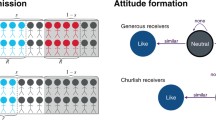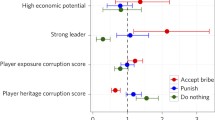Abstract
We present a theory of honor violence as a form of costly signaling. Two types of honor violence are identified: revenge and purification. Both types are amenable to a signaling analysis whereby the violent behavior is a signal that can be used by out-groups to draw inferences about the nature of the signaling group, thereby helping to solve perennial problems of social cooperation: deterrence and assurance. The analysis shows that apparently gratuitous acts of violence can be part of a system of norms that are Pareto superior to alternatives without such signals. For societies that lack mechanisms of governance to deter aggression or to enforce contracts, norms of honor can be a rational means of achieving these functions. The theory also suggests that cultures can become trapped in inefficient equilibria owing to path-dependent phenomena. In other words, costly signals of honor may continue to be sent even when they are no longer providing useful information.



Similar content being viewed by others
Notes
In honor societies, mad dogs are as dangerous as cowards, if not more so. Many of the norms regulating prison gangs, for instance, are related to preventing unauthorized violence between and within the different gangs. As David Skarbek (2014) shows in great detail in his study of the norms of American prison gangs, rules regulating violence are often highly specific about who may use violence on whom and under what circumstances. As Skarbek (2014:86) notes, in prisons, the gang “must authorize the use of violence because spontaneous, unplanned violence causes problems for other inmates.”
In some sense, the model we used to illuminate revenge-type violence involves signaling also, but game-theorists refer to such phenomena as involving reputation, rather than signaling: the “message” is intrinsic to the very behavior.
Such organizations also provide opportunities for gratifying mutual recognition and conferral of esteem (Brennan and Pettit 2006, chap. 11 §1).
Paralleling our model of honor killing, Rai and Sengupta (2013) provide a costly signaling model of premarital confinement in which women are supposed to have an underlying trait of “docility,” and the marginal cost to parents of confining a docile child is lower than the cost of confining a non-docile child. Thus, confinement itself is taken to be a credible signal of docility, which husbands in turn take as desirable in itself or indicative of the cost of future fertility controls.
In typical cases, the groom’s family won’t just be concerned with the chastity of the prospective bride, but of the entire extended family. For ease of presentation, we omit this complication below.
It must be conceded, however, that it is not clear what form typical honor violence takes, and hence what exactly the distribution of behavior is that demands explanation. Other sorts of honor violence may serve a similar role but are reported less readily, such as physical mutilation and incapacitation (Niaz 2003). Also, families may attempt to conceal a child’s transgression, rather than publicly punish it.
Kim Sterelny (2007) argues that marriage practices are in general much less likely to be subject to adaptive cultural group selection because there is limited opportunity to experiment with different marital norms within a human lifespan, and marriage practices are not modular: they are embedded in larger networks of social practices. The larger complex may be subject to adaptive pressures, but not the component parts.
References
Allen, D. W., & Reed, C. G. (2006). The duel of honor: Screening for unobservable social capital. American Law and Economics Review, 8(1), 81–115.
Appiah, K. A. (2011). The honor code: How moral revolutions happen. New York: W. W. Norton.
Barnes, C. D., Brown, R. P., & Tamborski, M. (2012). Living dangerously: Culture of honor, risk-taking, and the nonrandomness of “accidental” deaths. Social Psychological and Personality Science, 3(1), 100–107.
Benard, S. (2013). Reputation systems, aggression, and deterrence in social interaction. Social Science Research, 42(1), 230–245.
Benard, S. (2015). The value of vengefulness: Reputational incentives for initiating versus reciprocating aggression. Rationality and Society, 27(2), 129–160.
Bicchieri, C. (2002). Covenants without swords: Group identity, norms and communication in social dilemmas. Rationality and Society, 14(2), 192–228.
Bicchieri, C. (2006). The grammar of society: The nature and dynamics of social norms. Cambridge: Cambridge University Press.
Bicchieri, C. (2016). Norms in the wild. Cambridge: Cambridge University Press.
Black-Michaud, J. (1975). Cohesive force: Feud in the Mediterranean and the Middle East. Oxford: Basil Blackwell.
Boehm, C. (1986). Blood revenge: The enactment and management of conflict in Montenegro and other tribal societies. Philadelphia: University of Pennsylvania Press.
Brennan, G., & Pettit, P. (2006). The economy of esteem: An essay on civil and political society. Oxford: Oxford University Press.
Brennan, G., Eriksson, L., Goodin, R. E., & Southwood, N. (2013). Explaining norms. Oxford: Oxford University Press.
Chen, D. L. (2010). Club goods and group identity: Evidence from Islamic resurgence during the Indonesian financial crisis. Journal of Political Economy, 118(2), 300–354.
Chesler, P. (2010). Worldwide trends in honor killings. Middle East Quarterly, 17(2), 3–11.
Chesler, P., & Bloom, N. (2012). Hindu vs. Muslim honor killings. Middle East Quarterly, 19(3), 43.
Demetriou, D. (2014). What should realists say about honor cultures? Ethical Theory and Moral Practice, 17(5), 893–911.
Doris, J. M., & Plakias, A. (2008). How to argue about disagreement: Evaluative diversity and moral realism. In W. Sinnott-Armstrong (Ed.), Moral psychology, Vol 2. The cognitive science of morality: Intuition and diversity (pp. 303–331). Cambridge: MIT Press.
Efferson, C., Vogt, S., Elhadi, A., Ahmed, H. E. F., & Fehr, E. (2015). Female genital cutting is not a social coordination norm. Science, 349(6255), 1446–1447.
Elster, J. (1990). Norms of revenge. Ethics, 100(4), 862–885.
Fearon, J. D., & Laitin, D. D. (1996). Explaining interethnic cooperation. American Political Science Review, 90(4), 715–735.
Frank, R. (2005). Positional externalities cause large and preventable welfare losses. The American Economic Review, 95(2), 137–141.
Gambetta, D. (2009). Codes of the underworld: How criminals communicate. Princeton: Princeton University Press.
Getty, T. (1998). Handicap signalling: When fecundity and viability do not add up. Animal Behaviour, 56(1), 127–130.
Ginsburg, T. (2011). An economic interpretation of the Pashtunwali. University of Chicago Legal Forum, 2011, 89.
Gintis, H., Smith, E., & Bowles, S. (2001). Costly signaling and cooperation. Journal of Theoretical Biology, 213(1), 103–119.
Grafen, A. (1990). Biological signals as handicaps. Journal of Theoretical Biology, 144(4), 517–546.
Greif, A. (2006). Institutions and the path to the modern economy: Lessons from medieval trade. Cambridge: Cambridge University Press.
Grosjean, P. (2014). A history of violence: The culture of honor and homicide in the US south. Journal of the European Economic Association, 12(5), 1285–1316.
Hobbes, Thomas. 2012. Leviathan. Edited by Noel Malcolm. Clarendon Edition of the Works of Thomas Hobbes. Oxford: Oxford University Press, Leviathan.
Howard, J. A., & Gibson, M. A. (2017). Frequency-dependent female genital cutting behaviour confers evolutionary fitness benefits. Nature Ecology & Evolution, 1. https://doi.org/10.1038/s41559-016-0049.
Iannaccone, L. R. (1992). Sacrifice and stigma: Reducing free-riding in cults, communes, and other collectives. Journal of Political Economy, 100(2), 271–291.
Iannaccone, L. R., & Berman, E. (2006). Religious extremism: The good, the bad, and the deadly. Public Choice, 128(1–2), 109–129.
Johnstone, R. A. (1997). The evolution of animal signals. In J. R. Krebs & N. B. Davies (Eds.), Behavioural Ecology: An Evolutionary Approach (fourth ed., pp. 155–78). Wiley.
Kreps, D. M., & Wilson, R. (1982). Reputation and imperfect information. Journal of Economic Theory, 27(2), 253–279.
Kressel, G. M., Bausani, A., Ginat, J., Roger, J., Khazanov, A. M., Landau, S. F., Marx, E., & Shokeid, M. (1981). Sororicide/Filiacide: Homicide for family honour [and comments and reply]. Current Anthropology, 22(2), 141–158.
Kulczycki, A., & Windle, S. (2011). Honor killings in the Middle East and North Africa: A systematic review of the literature. Violence Against Women, 17(11), 1442–1464.
Kumar, V., & Campbell, R. (2016). Honor and moral revolution. Ethical Theory and Moral Practice, 19(1), 147–159.
Lachmann, M., Számadó, S., & Bergstrom, C. T. (2001). Cost and conflict in animal signals and human language. Proceedings of the National Academy of Sciences, 98(23), 13189–13194.
Mackie, G. (1996). Ending footbinding and infibulation: A convention account. American Sociological Review, 61(6), 999–1017.
Mahdi, N. Q. (1986). Pukhtunwali: Ostracism and honor among the Pathan Hill tribes. Ethology and Sociobiology, 7(3), 295–304.
McElreath, R. (2003). Reputation and the evolution of conflict. Journal of Theoretical Biology, 220(3), 345–357.
Miller, W. (1990). Bloodtaking and peacemaking: Feud, law, and society in Saga Iceland. Chicago: University of Chicago Press.
Moritz, M. (2008). A critical examination of honor cultures and herding societies in Africa. African Studies Review, 51(2), 99–117.
Niaz, U. (2003). Violence against women in south Asian countries. Archives of Women’s Mental Health, 6(3), 173–184.
Nisbett, R., & Cohen, D. (1996). Culture of honor: The psychology of violence in the south. Boulder: Westview Press.
Parla, A. (2001). The “honor” of the state: Virginity examinations in Turkey. Feminist Studies, 27(1), 65–88.
Pelin, S. Þ. (1999). The question of virginity testing in Turkey. Bioethics, 13(3–4), 256–261.
Rai, B., & Sengupta, K. (2013). Pre-marital confinement of women: A signaling and matching approach. Journal of Development Economics, 105, 48–63.
Ross, C. T., Strimling, P., Ericksen, K. P., Lindenfors, P., & Mulder, M. B. (2016). The origins and maintenance of female genital modification across Africa. Human Nature, 27(2), 173–200.
Schneider, J. (1971). Of vigilance and virgins: Honor, shame and access to resources in Mediterranean societies. Ethnology, 10(1), 1–24.
Selten, R. (1978). The chain store paradox. Theory and Decision, 9(2), 127–159.
Sessions, W. (2010). Honor for us: A philosophical analysis, interpretation and defense. London: Continuum.
Shafa, S., Harinck, F., Ellemers, N., & Beersma, B. (2014). Who are you calling rude? Honor-related differences in morality and competence evaluations after an insult. Negotiation and Conflict Management Research, 7(1), 38–56.
Skarbek, D. (2011). Governance and prison gangs. American Political Science Review, 105(4), 702–716.
Skarbek, D. (2014). The social order of the underworld: How prison gangs govern the American penal system. Oxford: Oxford University Press.
Skyrms, B. (2010). Signals: Evolution, learning, and information. Oxford: Oxford University Press.
Spence, M. (1973). Job market signaling. The Quarterly Journal of Economics, 87(3), 355–374.
Sterelny, K. (2007). SNAFUS: An evolutionary perspective. Biological Theory, 2(3), 317–328.
Thrasher, J., & Vallier, K. (2015). The fragility of consensus. European Journal of Philosophy, 23(4), 933–954.
United Nations Population Fund. (2000). Violence against women and girls: A human rights and health priority. The State of World Population, 2000, 25–30 https://www.unfpa.org/publications/state-world-population-2000.
Weiner, M. S. (2013). The rule of the clan: What an ancient form of social organization reveals about the future of individual freedom. New York: Farrar, Straus and Giroux.
Acknowledgments
We thank Keith Hankins, Cristina Bicchieri, Lata Gangadharan, Jerry Gaus, Shaun Nichols, David Skarbek, Lijia Tan, Kevin Zollman, Frank Calegari, Birendra Rai, Klaus Abbink, and audiences at the University of Arizona, Australian National University, and Monash University for suggestions and comments. This research was supported by the Australian Research Council, DP150100242 (TH) and DP170102834 (TH and JT).
Author information
Authors and Affiliations
Corresponding author
Electronic supplementary material
ESM 1
(PDF 111 kb)
Rights and permissions
About this article
Cite this article
Thrasher, J., Handfield, T. Honor and Violence. Hum Nat 29, 371–389 (2018). https://doi.org/10.1007/s12110-018-9324-4
Published:
Issue Date:
DOI: https://doi.org/10.1007/s12110-018-9324-4




